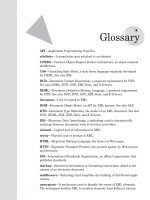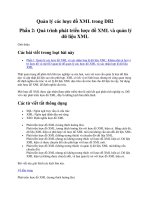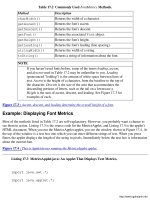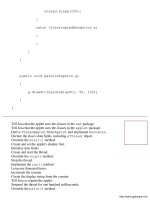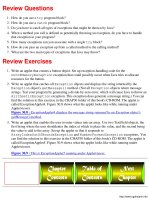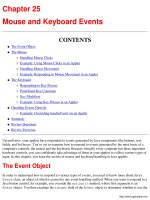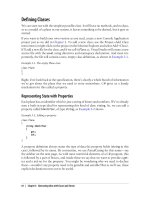programming XML by Example phần 2 ppt
Bạn đang xem bản rút gọn của tài liệu. Xem và tải ngay bản đầy đủ của tài liệu tại đây (432.39 KB, 53 trang )
To apply the magic of XSL, you will use an XSL processor. There also are
many XSL processors available, such as LotusXSL.
✔ XSL processors are discussed in Chapter 5, “XSL Transformation.”
What’s Next
The book is organized as follows:
• Chapters 2 through 4 will teach you the XML syntax, including the
syntax for DTDs and namespaces.
• Chapters 5 and 6 will teach you how to use style sheets to publish
documents.
• Chapters 7, 8, and 9 will teach you how to manipulate XML docu-
ments from JavaScript applications.
• Chapter 10 will discuss the topic of modeling. You have seen in this
introduction how structure is important for XML. Modeling is the
process of creating the structure.
• Chapter 11, “N-Tiered Architecture and XML,” and Chapter 12,
“Putting It All Together: An e-Commerce Example,” will wrap it up
with a realistic electronic commerce application. This application exer-
cises most if not all the techniques introduced in the previous chap-
ters.
• Appendix A will teach you just enough Java to be able to follow the
examples in Chapters 8 and 12. It also discusses when you should use
JavaScript and when you should use Java.
38
Chapter 1: The XML Galaxy
03 2429 CH01 2.29.2000 2:18 PM Page 38
03 2429 CH01 2.29.2000 2:18 PM Page 39
04 2429 CH02 11/12/99 1:00 PM Page 40
2
The XML Syntax
In this chapter, you will learn the syntax used for XML documents. More
specifically, you will learn
• how to write and read XML documents
• how XML structures documents
• how and where XML can be used
If you are curious, the latest version of the official recommendation is
always available from www.w3.org/TR/REC-xml. XML version 1.0 (the version
used in this book) is available from www.w3.org/TR/1998/REC-xml-19980210.
04 2429 CH02 11/12/99 1:00 PM Page 41
A First Look at the XML Syntax
If I had to summarize XML in one sentence, it would be something like “a
set of standards to exchange and publish information in a structured man-
ner.” The emphasis on structure cannot be underestimated.
XML is a language used to describe and manipulate structured documents.
XML documents are not limited to books and articles, or even Web sites,
and can include objects in a client/server application.
However, XML offers the same tree-like structure across all these applica-
tions. XML does not dictate or enforce the specifics of this structure—it
does not dictate how to populate the tree.
XML is a flexible mechanism that accommodates the structure of specific
applications. It provides a mechanism to encode both the information
manipulated by the application and its underlying structure.
XML also offers several mechanisms to manipulate the information—that
is, to view it, to access it from an application, and so on. Manipulating doc-
uments is done through the structure. So we are back where we started:
The structure is the key.
Getting Started with XML Markup
Listing 2.1 is a (small) address book in XML. It has only two entries: John
Doe and Jack Smith. Study it because we will use it throughout most of
this chapter and the next.
Listing 2.1: An Address Book in XML
<?xml version=”1.0”?>
<! loosely inspired by vCard 3.0 >
<address-book>
<entry>
<name>John Doe</name>
<address>
<street>34 Fountain Square Plaza</street>
<region>OH</region>
<postal-code>45202</postal-code>
<locality>Cincinnati</locality>
<country>US</country>
</address>
<tel preferred=”true”>513-555-8889</tel>
<tel>513-555-7098</tel>
<email href=”mailto:”/>
42
Chapter 2: The XML Syntax
EXAMPLE
04 2429 CH02 11/12/99 1:00 PM Page 42
</entry>
<entry>
<name><fname>Jack</fname><lname>Smith</lname></name>
<tel>513-555-3465</tel>
<email href=”mailto:”/>
</entry>
</address-book>
As you can see, an XML document is textual in nature. XML-wise, the doc-
ument consists of character data and markup. Both are represented by text.
Ultimately, it’s the character data we are interested in because that’s the
information. However, the markup is important because it records the
structure of the document.
There are a variery of markup constructs in XML but it is easy to recognize
the markup because it is always enclosed in angle brackets.
NOTE
vCard is a standard for electronic business cards. In the next chapter, you will learn
where I used the vCard standard in preparing this example.
Obviously, it’s the markup that differentiates the XML document from plain
text. Listing 2.2 is the same address in plain text, with no markup and only
character data.
Listing 2.2: The Address Book in Plain Text
John Doe
34 Fountain Square Plaza
Cincinnati, OH 45202
US
513-555-8889 (preferred)
513-555-7098
Jack Smith
513-555-3465
Listing 2.2 helps illustrate the benefits of a markup language. Listing 2.1
and 2.2 carry exactly the same information. Because Listing 2.2 has no
markup, it does not record its own structure.
In both cases, it is easy to recognize the names, the phone numbers, the
email addresses, and so on. If anything, Listing 2.2 is probably more read-
able.
43
A First Look at the XML Syntax
EXAMPLE
04 2429 CH02 11/12/99 1:00 PM Page 43
For software, however, it’s exactly the opposite. Software needs to be told
which is what. It needs to be told what the name is, what the address is,
and so on. That’s what the markup is all about; it breaks the text into its
constituents so software can process it.
Software does have one major advantage—speed. While it would take you a
long time to sort through a long list of a thousand addresses, software will
plunge through the same list in less than a minute.
However, before it can start, it needs to have the information in a predi-
gested format. This chapter and the following two chapters will concentrate
on XML as a predigested format.
The reward comes in Chapter 5, “XSL Transformation,” and subsequent
chapters where we will see how to tell the computer to do something useful
with these documents.
Element’s Start and End Tags
The building block of XML is the element, as that’s what comprises XML
documents. Each element has a name and a content.
<tel>513-555-7098</tel>
The content of an element is delimited by special markups known as start
tag and end tag. The tagging mechanism is similar to HTML, which is logi-
cal because both HTML and XML inherited their tagging from SGML.
The start tag is the name of the element (tel in the example) in angle
brackets; the end tag adds an extra slash character before the name.
Unlike HTML, both start and end tags are required. The following is not
correct in XML:
<tel>513-555-7098
It can’t be stressed enough that XML does not define elements. Nowhere in
the XML recommendation will you find the address book of Listing 2.1 or
the tel element. XML is an enabling standard that provides a common syn-
tax to store information according to a structure.
In this respect, I liken XML to SQL. SQL is the language you use to pro-
gram relational databases such as Oracle, SQL Server, or DB2. SQL pro-
vides a common language to create and manage relational databases.
However, SQL does not specify what you should store in these database or
which tables you should use.
Still, the availability of a common language has led to the development of a
lively industry. SQL vendors provide databases, modeling and development
tools, magazines, seminars, conferences, training, books, and more.
44
Chapter 2: The XML Syntax
EXAMPLE
04 2429 CH02 11/12/99 1:00 PM Page 44
Admittedly, the XML industry is not as large as the SQL industry, but it’s
catching up fast. By moving your data to XML rather than an esoteric syn-
tax, you can tap the growing XML industry for support.
Names in XML
Element names must follow certain rules. As we will see, there are other
names in XML that follow the same rules.
Names in XML must start with either a letter or the underscore character
(“_”). The rest of the name consists of letters, digits, the underscore charac-
ter, the dot (“.”), or a hyphen (“-”). Spaces are not allowed in names.
Finally, names cannot start with the string “xml”, which is reserved for the
XML specification itself.
NOTE
There is one more character you can use in names—the colon (:). However, the colon is
reserved for namespaces; therefore, it will be introduced in Chapter 4, “Namespaces.”
The following are examples of valid element names in XML:
<copyright-information>
<p>
<base64>
<décompte.client>
<firstname>
The following are examples of invalid element names. You could not use
these names in XML:
<123>
<first name>
<tom&jerry>
Unlike HTML, names are case sensitive in XML. So, the following names
are all different:
<address>
<ADDRESS>
<Address>
By convention, HTML elements in XML are always in uppercase. (And, yes,
it is possible to include HTML elements in XML documents. In Chapter 5,
you will see when it is useful.)
By convention, XML elements are frequently written in lowercase. When a
name consists of several words, the words are usually separated by a
hyphen, as in address-book.
45
A First Look at the XML Syntax
EXAMPLE
04 2429 CH02 11/12/99 1:00 PM Page 45
Another popular convention is to capitalize the first letter of each word and
use no separation character as in AddressBook.
There are other conventions but these two are the most popular. Choose the
convention that works best for you but try to be consistent. It is difficult to
work with documents that mix conventions, as Listing 2.3 illustrates.
Listing 2.3: A Document with a Mix of Conventions
<?xml version=”1.0”?>
<address-book>
<ENTRY>
<name>John Doe</name>
<Address>
<street>34 Fountain Square Plaza</street>
<Region>OH</Region>
<PostalCode>45202</PostalCode>
<locality>Cincinnati</locality>
<country>US</country>
</Address>
<TEL PREFERRED=”true”>513-555-8889</TEL>
<TEL>513-555-7098</TEL>
<email href=”mailto:”/>
</ENTRY>
</address-book>
Although the document in Listing 2.3 is well-formed XML, it is difficult to
work with it because you never know how to write the next element. Is it
Address or address or ADDRESS? Mixing case is cumbersome and is consid-
ered a poor style.
NOTE
As we will see in the “Unicode” section, XML supports characters from most spoken
languages. You can use letters from any alphabet in names, including letters from the
Greek, Japanese, or Cyrillic alphabets.
Attributes
It is possible to attach additional information to elements in the form of
attributes. Attributes have a name and a value. The names follow the same
rules as element names.
Again, the syntax is similar to HTML. Elements can have one or more
attributes in the start tag, and the name is separated from the value by the
equal character. The value of the attribute is enclosed in double or single
quotation marks.
46
Chapter 2: The XML Syntax
EXAMPLE
04 2429 CH02 11/12/99 1:00 PM Page 46
For example, the tel element can have a preferred attribute:
<tel preferred=”true”>513-555-8889</tel>
Unlike HTML, XML insists on the quotation marks. The XML processor
would reject the following:
<tel preferred=true>513-555-8889</tel>
The quotation marks can be either single or double quotes. This is conve-
nient if you need to insert single or double quotation marks in an attribute
value.
<confidentiality level=”I don’t know”>
This document is not confidential.
</confidentiality>
or
<confidentiality level=’approved “for your eyes only”’>
This document is top-secret
</confidentiality>
Empty Element
Elements that have no content are known as empty elements. Usually, they
are enclosed in the document for the value of their attributes.
There is a shorthand notation for empty elements: The start and end tags
merge and the slash from the end tag is added at the end of the opening
tag.
For XML, the following two elements are identical:
<email href=”mailto:”/>
<email href=”mailto:”></email>
Nesting of Elements
As Listing 2.1 illustrates, element content is not limited to text; elements
can contain other elements that in turn can contain text or elements and
so on.
An XML document is a tree of elements. There is no limit to the depth of
the tree, and elements can repeat. As you see in Listing 2.1, there are two
entry elements in the address-book element. The entry for John Doe has
two tel elements. Figure 2.1 is the tree of Listing 2.1.
47
A First Look at the XML Syntax
EXAMPLE
EXAMPLE
EXAMPLE
04 2429 CH02 11/12/99 1:00 PM Page 47
Figure 2.1: Tree of the address book
An element that is enclosed in another element is called a child. The ele-
ment it is enclosed into is its parent. In the following example, the name
element has two children: the fname and the lname elements. name is the
parent of both elements.
<name>
<fname>Jack</fname>
<lname>Smith</lname>
</name>
Start and end tags must always be balanced and children are always com-
pletely enclosed in their parents. In other words, it is not possible that the
end tag of a child appears after the end tag of its parent. So, the following
is illegal:
<name><fname>Jack</fname><lname>Smith</name></lname>
NOTE
It is not an accident if XML documents are trees. Trees are flexible, simple, and power-
ful. In particular, trees can be used to serialize any data structure.
XML is particularly well adapted to serialize objects from object-oriented languages
such as JavaScript, Java, or C++.
Root
At the root of the document there must be one and only one element. In
other words, all the elements in the document must be the children of a sin-
gle element. The following example is illegal because there are two entry
elements that are not enclosed in a top-level element:
<?xml version=”1.0”?>
<entry>
<name>John Doe</name>
48
Chapter 2: The XML Syntax
EXAMPLE
EXAMPLE
04 2429 CH02 11/12/99 1:00 PM Page 48
<email href=”mailto:”/>
</entry>
<entry>
<name>JackSmith</name>
<email href=”mailto:”/>
</entry>
It is easy to fix the previous example. It suffices to introduce a new root,
such as address-book.
<?xml version=”1.0”?>
<address-book>
<entry>
<name>John Doe</name>
<email href=”mailto:”/>
</entry>
<entry>
<name>JackSmith</name>
<email href=”mailto:”/>
</entry>
</address-book>
There is no rule that says the top-level element must be address-book.
If there is only one entry, then entry can act as the top-level element.
<?xml version=”1.0”?>
<entry>
<name>John Doe</name>
<email href=”mailto:”/>
</entry>
XML Declaration
The XML declaration is the first line of the document. The declaration iden-
tifies the document as an XML document. The declaration also lists the
version of XML used in the document. For the time being, it’s 1.0.
<?xml version=”1.0”?>
An XML processor can reject documents that have another version number.
The declaration can contain other attributes to support other features such
as character set encoding. The attributes are introduced with the feature
they support in this chapter and the next chapter.
49
A First Look at the XML Syntax
EXAMPLE
EXAMPLE
EXAMPLE
04 2429 CH02 11/12/99 1:00 PM Page 49
The XML declaration is optional. The following document is valid even
though it doesn’t have a declaration:
<address-book>
<entry>
<name>John Doe</name>
<email href=”mailto:”/>
</entry>
<entry>
<name>JackSmith</name>
<email href=”mailto:”/>
</entry>
</address-book>
If the declaration is included however, it must start on the first character of
the first line of the document. The XML recommendation suggests you
include the declaration in every XML document.
Advanced Topics
As you can see, the core of the XML syntax is not difficult. Furthermore, if
you already know HTML, XML is familiar.
One of the design goals of XML was to develop a simple markup language
that would be easy to use and would remain human-readable. I think it
achieved that goal.
This section covers more advanced features of XML. You might not use
them in every document, but they are often useful.
Comments
To insert comments in a document, enclose them between “<! ” and “ >”.
Comments are used for notes, indication of ownership, and more. They are
intended for the human reader and they are ignored by the XML processor.
In the following example, a comment is made that the document was
inspired by vCard. The software does nothing with this comment but it
helps us next time we open this document.
<! loosely inspired by vCard 3.0 >
Comments cannot be inserted in the markup. They must appear before or
after the markup.
Unicode
Characters in XML documents follow the Unicode standard. Unicode is a
major extension to the familiar ASCII character set. The Unicode
50
Chapter 2: The XML Syntax
EXAMPLE
EXAMPLE
04 2429 CH02 11/12/99 1:00 PM Page 50
Consortium (www.unicode.org) is responsible for publishing and maintain-
ing the Unicode standard. The same standard is published by ISO as
ISO/IEC 10646.
Unicode supports all spoken languages (on Earth) as well as mathematical
and other symbols. It supports English, Western European languages,
Cyrillic, Japanese, Chinese, and so on.
Support for Unicode is a major step forward in the internationalization of
the Web. Unicode also is supported in Windows NT.
However, to accommodate all those characters, Unicode needs 16 bits per
character. We are used to character sets, such as Latin-1 (Windows default
character set), that use only 8 bits per character. However, 8 bits supports
only 256 choices—not enough for Japanese, not to mention Japanese and
Chinese and English and Greek and Norwegian and more.
Unicode characters are twice as large as their Latin-1 equivalent; logically,
XML documents should be twice as large as normal text files. Fortunately,
there is a workaround. In most cases, we don’t need 16 bits and we can
encode XML documents with an 8-bit character set.
XML processor must recognize the UTF-8 and UTF-16 encodings. As the
name implies, UTF-8 uses 8 bits for English characters. Most processors
support other encodings. In particular, for Western European languages,
they support ISO 8859-1 (the official name for Latin-1).
Documents that use encoding other than UTF-8 or UTF-16 must start with
an XML declaration. The declaration must have an attribute encoding to
announce the encoding used.
For example, a document written in Latin-1 (such as with Windows
Notepad) could use the following declaration:
<?xml version=”1.0” encoding=”ISO-8859-1”?>
<entrée>
<nom>José Dupont<nom/>
<email href=”mailto:”/>
</entrée>
NOTE
You might wonder how the XML processor can read the encoding parameter. Indeed, to
reach the encoding parameter, the processor must read the declaration. However, to
read the declaration, the processor needs to know which encoding is being used.
This looks like a dog running after his tail until you realize that the first characters of
an XML document always are <?xml. The XML processor can match these four charac-
ters against the encoding it supports and guess enough of the encoding (is it 8 or 16
bits?) to read the declaration.
51
Advanced Topics
EXAMPLE
continues
04 2429 CH02 11/12/99 1:00 PM Page 51
What about those documents that have no declaration (since the declaration is
optional)? These documents must use one of the default encoding parameters (UTF-8
or UTF-16). Again, the XML processor can match the first character (which must be a <)
against its encoding in UTF-8 or UTF-16.
Entities
The document in Listing 2.1 (page 42) is self-contained: The document is
complete and it can be stored in just one file. Complex documents are often
split over several files: the text, the accompanying graphics, and so on.
XML, however, does not reason in terms of files. Instead it organizes docu-
ments physically in entities. In some cases, entities are equivalent to files;
in others, they are not.
XML entities is a complex topic that we will revisit in the next chapter,
when we will see how to declare entities in the DTD. In this chapter, we
will see how to use entities.
Entities are inserted in the document through entity references (the name of
the entity between an ampersand character and a semicolon). For the appli-
cation, the entity reference is replaced by the content of the entity. If we
assume we have defined an entity “us,” which has the value “United
States,” the following two lines are equivalent:
<country>&us;</country>
<country>United States</country>
XML predefines entities for the characters used in markup (angle brackets,
quotes, and so on). The entities are used to escape the characters from ele-
ment or attribute content. The entities are
• < left angle bracket “<” must be escaped with <
• & ampersand “&” must be escaped with &
• > right angle bracket “>” must be escaped with > in the combi-
nation ]]> in CDATA sections (see the following)
• ' single quote “‘” can be escaped with ' essentially in para-
meter value
• " double quote “”” can be escaped with " essentially in
parameter value
The following is not valid because the ampersand would confuse the XML
processor:
<company>Mark & Spencer</company>
Instead, it must be rewritten to escape the ampersand bracket with an
& entity:
52
Chapter 2: The XML Syntax
EXAMPLE
EXAMPLE
04 2429 CH02 11/12/99 1:00 PM Page 52
<company>Mark & Spencer</company>
XML also supports character references where a letter is replaced by its
Unicode character code. For example, if your keyboard does not support
accentuated letters, you can still write my name in XML as:
<name>Benoît Marchal</name>
Character references that start with &#x provides a hexadecimal represen-
tation of the character code. Character references that start with &#
provide a decimal representation of the character code.
TIP
Under Windows, to find the character code of most characters, you can use the
Character Map. The character code appears in the status bar (see Figure 2.2).
53
Advanced Topics
Figure 2.2: The character code in Character Map
Special Attributes
XML defines two attributes:
• xml:space for those applications that discard duplicate spaces (similar
to Web browsers that discard unnecessary spaces in HTML). This
attribute controls whether the application can discard spaces. If set to
preserve, the application should preserve all spaces in this element
and its children. If set to default, the application can use its default
space handling.
• xml:lang in publishing, it is often desirable to know in which language
the content is written. This attribute can be used to indicate the lan-
guage of the element’s content. For example:
<p xml:lang=”en-GB”>What colour is it?</p>
<p xml:lang=”en-US”>What color is it?</p>
Processing Instructions
Processing instructions (abbreviated PI) is a mechanism to insert non-XML
statements, such as scripts, in the document.
EXAMPLE
Character code
04 2429 CH02 11/12/99 1:00 PM Page 53
At first sight, processing instruction is at odds with the XML concept that
processing is always derived from the structure. As we saw in the first
chapter, with SGML and XML, processing is derived from the structure of
the document. There should be no need to insert specific instructions in a
document. This is one of the major improvements of SGML when compared
to earlier markup languages.
That’s the theory. In practice, there are cases where it is easier to insert
processing instructions rather than define complex structure. Processing
instructions are a concession to reality from the XML standard developers.
You already are familiar with processing instructions because the XML dec-
laration is a processing instruction:
<?xml version=”1.0” encoding=”ISO-8859-1”?>
✔ In Chapter 5, “XSL Transformation,” you will see how to use processing instructions to
attach style sheets to documents (page 125).
<?xml-stylesheet href=”simple-ie5.xsl” type=”text/xsl”?>
Finally, processing instructions are used by specific applications. For exam-
ple, XMetaL (an XML editor) uses them to create templates. This process-
ing instruction is specific to XMetaL:
<?xm-replace_text {Click here to type the name}?>
The processing instruction is enclosed in <? and ?>. The first name is the
target. It identifies the application or the device to which the instructions
are directed. The rest of the processing instructions are in a format specific
to the target. It does not have to be XML.
CDATA Sections
As you have seen, markup characters (left angle bracket and ampersand)
that appear in the content of an element must be escaped with an entity.
For some applications, it is difficult to escape markup characters, if only
because there are too many of them. Mathematical equations can use many
left angle brackets. It is difficult to include a scripting language in a docu-
ment and to escape the angle brackets and ampersands. Also, it is difficult
to include an XML document in an XML document.
CDATA sections are intended for these cases. CDATA sections are delimited
by “<[CDATA[” and “]]>”. The XML processor ignores all markup except for
]]> (which means it is not possible to include a CDATA section in another
CDATA section).
54
Chapter 2: The XML Syntax
EXAMPLE
04 2429 CH02 11/12/99 1:00 PM Page 54
The following example uses a CDATA section to insert an XML example
into an XML document:
<?xml version=”1.0”?>
<example>
<[CDATA[
<?xml version=”1.0”?>
<entry>
<name>John Doe</name>
<email href=”mailto:”/>
</entry>]]>
</example>
NOTE
CDATA stands for character data. In the next chapters you will see that text in an ele-
ment is called PCDATA, parsed character data.
The difference between CDATA and PCDATA is that PCDATA cannot contain markup char-
acters.
Frequently Asked Questions on XML
This completes our study of the XML syntax. The only aspect of the XML
recommendation we haven’t studied yet is the DTD. The DTD is discussed
in Chapter 3, “XML Schemas.”
Before moving to the DTD, however, I’d like to answer three common ques-
tions on XML documents.
Code Indenting
Listing 2.1 is indented to make the tree more apparent. Although it is not
required for the XML processor, it makes the code more readable as we can
see immediately where an element starts and ends.
This raises the question of what the processor does with the whitespaces
used for indenting. Does it ignore it? The answer is a qualified yes.
Strictly speaking, the XML processor does not ignore whitespaces. In the
following example, it sees the content of
name as a line break, three spaces,
fname, another line break, three spaces, lname, and a line break.
<name>
<fname>Jack</fname>
<lname>Smith</lname>
</name>
55
Frequently Asked Questions on XML
EXAMPLE
EXAMPLE
04 2429 CH02 11/12/99 1:00 PM Page 55
But in the following case, it sees the content of name as just fname and
lname. No indenting.
<name><fname>Jack</fname><lname>Smith</lname></name>
It is easy to filter unwanted whitespaces and most applications do it. For
example, XSL (XML Style Sheet Language) ignores what it recognizes as
indenting.
Likewise, some XML editors give you the option of indenting source code
automatically. If they indent the code, they will ignore indenting in the doc-
ument.
If whitespaces are important for your document, then you should use the
xml:space attribute that was introduced earlier.
Why the End Tag?
At first, the need to terminate each element with an end tag is annoying.
It is required because XML does not have predefined elements.
An HTML browser can work out when an element has no closing tags
because it knows the structure of the document, it knows which elements
are allowed where, and it can deduce where each element should end.
Indeed, if the following is an HTML fragment, a browser does not need end
tags for paragraphs, nor does it need an empty tag for the break (see
Listing 2.4):
Listing 2.4: An HTML Document Needs No End Tags
<P><B>John Doe</B>
<P>34 Fountain Square Plaza<BR>
Cincinnati, OH 45202<BR>
US
<P>Tel: 513-555-8889
<P>Tel: 513-555-7098
<P>Email:
The browser can deduce where the paragraphs end because it knows that
paragraphs cannot nest. Therefore, the beginning of a new paragraph must
coincide with the end of the previous one. Likewise, the browser knows
that the break is an empty element. Because of all this a priori knowledge,
the browser can “fill in the blank” and know the document must be inter-
preted as
<P><B>John Doe</B></P>
<P>34 Fountain Square Plaza<BR></BR>
Cincinnati, OH 45202<BR></BR>
56
Chapter 2: The XML Syntax
EXAMPLE
EXAMPLE
04 2429 CH02 11/12/99 1:00 PM Page 56
US</P>
<P>Tel: 513-555-8889</P>
<P>Tel: 513-555-7098</P>
<P>Email: </P>
However, an XML processor does not know the structure of the document
because you define your own tags. So, an XML processor does not know
that p elements (it does not know they are paragraphs, either) cannot nest.
If Listing 2.4 was XML, the processor could interpret it as
<P><B>John Doe</B>
<P>34 Fountain Square Plaza
<BR>Cincinnati, OH 45202</BR>
<BR>US</BR>
<P>Tel: 513-555-8889
<P>Tel: 513-555-7098
<P>Email:
</P
>
</P>
</P>
</P>
</P>
or as:
<P><B>John Doe</B></P>
<P>34 Fountain Square Plaza
<BR>Cincinnati, OH 45202</BR>
<BR/>US
<P>Tel: 513-555-8889</P>
<P>Tel: 513-555-7098</P>
</P>
<P>Email: </P>
There are many other possibilities and that’s precisely the problem.
The processor wouldn’t know which one to pick so the markup has to be
unambiguous.
TIP
In the next chapter, you will see how to declare the structure of documents with DTDs.
Theoretically, the XML processor could use the DTD to resolve ambiguities in the
markup. Indeed, that’s how SGML processors work. However, you also will learn that
a category of XML processors ignores DTDs.
57
Frequently Asked Question on XML
04 2429 CH02 11/12/99 1:00 PM Page 57
XML and Semantic
It is important to realize that XML alone does not define the semantic (the
meaning) of the document. The element names are meaningful only to
humans. They are meaningless to the XML processor.
The processor does not know what a name is. And it does not know the dif-
ference between a name and an address, apart from the fact that an address
has more children than a name. For the XML processor, Listing 2.5, where
the element names are totally mixed up, is as good as Listing 2.1.
Listing 2.5: Meaningless Names
<?xml version=”1.0”?>
<name>
<tel>
<street>John Doe</street>
<country>
<email>34 Fountain Square Plaza</email>
<locality>OH</locality>
<region>45202</region>
<postal-code>Cincinnati</postal-code>
<address>US</address>
</country>
<tel preferred=”true”>513-555-8889</tel>
<tel>513-555-7098</tel>
<address-book href=”mailto:”/>
</tel>
<tel>
<street>Jack Smith</street>
<tel>513-555-3465</tel>
<address-book href=”mailto:”/>
</tel>
</name>
The semantic of an XML document is provided by the application. As we
will see in Chapter 5 and later, some XML companion standards deal with
some aspects of semantic.
For example, XSL describes how to present information. It provides format-
ting semantic for a document. XLink and RDF (Resource Definition
Framework) can be used to describe the relationships between documents.
58
Chapter 2: The XML Syntax
EXAMPLE
04 2429 CH02 11/12/99 1:00 PM Page 58
Four Common Errors
As you have seen, the XML syntax is very strict: Elements must have both
a start and end tag, or they must use the special empty element tag;
attribute values must be fully quoted; there can be only one top-level ele-
ment; and so on.
A strict syntax was a design goal for XML. The browser vendors asked for
it. HTML is very lenient, and HTML browsers accept anything that looks
vaguely like HTML. It might have helped with the early adoption of HTML
but now it is a problem.
Studies estimate that more than 50% of the code in a browser deals with
errors or the sloppiness of HTML authors. Consequently, an HTML browser
is difficult to write, it has slowed competition, and it makes for mega-
downloads.
It is expected that in the future, people will increasingly rely on PDAs
(Personal Digital Assistants like the PalmPilot) or portable phones to access
the Web. These devices don’t have the resources to accommodate a complex
syntax or megabyte browsers.
In short, making XML stricter meant simplifying the work of the program-
mers and that translates into more competition, more XML tools, smaller
tools that fit in smaller devices, and, hopefully, faster tools.
Yet, it means that you have to be very careful about what you write. This is
particularly true if you are used to writing HTML documents. In this sec-
tion, I review the four most common errors in writing XML code.
Forget End Tags
For reasons explained previously, end tags are mandatory (except for empty
elements). The XML processor would reject the following because street and
country have no end tags:
<address>
<street>34 Fountain Square Plaza
<region>OH</region>
<postal-code>45202</postal-code>
<locality>Cincinnati</locality>
<country>US
</address>
59
Four Common Errors
EXAMPLE
04 2429 CH02 11/12/99 1:00 PM Page 59
Forget That XML Is Case Sensitive
XML names are case sensitive. The following two elements are different
for XML. The first one is a “tel” element whereas the second one is a “TEL”
element:
<tel>513-555-7098</tel>
<TEL>513-555-7098</TEL>
A popular variation on this error is to use a different case in the opening
and closing tag of an element:
<tel>513-555-7098</TEL>
Introduce Spaces in the Name of Element
It is illegal to introduce spaces in the name of elements. The XML processor
interprets spaces as the beginning of an attribute. The following example is
not valid because address book has a space in it:
<address book>
<entry>
<name>John Doe</name>
<email href=”mailto:”/>
</entry>
</address book>
Forget the Quotes for Attribute Value
Unlike HTML, XML forces you to quote attribute values. The following is
not acceptable:
<tel preferred=true>513-555-8889</tel>
A popular variation on this error is to forget the closing quote. The XML
processor assumes that the content of the element is part of the attribute,
which is guaranteed to produce funny results! The following is incorrect
because the attribute has no closing quote:
<tel preferred=”true>513-555-8889</tel>
XML Editors
If you are like me, you will soon hate writing XML by hand. It’s not that
the syntax is difficult, but it is annoying to remember to close every ele-
ment and to escape left angle brackets.
Fortunately, there are several XML editors on the market that can help you
with writing XML code. XML Notepad from Microsoft is a simple but effec-
tive editor. Notepad divides the screen into two panes. In the left pane, it
60
Chapter 2: The XML Syntax
EXAMPLE
EXAMPLE
EXAMPLE
EXAMPLE
04 2429 CH02 11/12/99 1:00 PM Page 60
shows the document tree (Structure); in the right pane, the content
(Values). Figure 2.3 shows XML Notepad.
61
Three Applications of XML
Figure 2.3: XML Notepad
Best of all, XML Notepad is free. You can download it from
www.microsoft.com. Search for “XML Notepad.” At the time of this writing,
XML Notepad was still in beta. Take a moment to review the release notes
to see how final the version you download is. Note XML Notepad works bet-
ter if Internet Explorer 5.0 is installed. More specifically, if you are using
Internet Explorer 4.0, all names are converted to uppercase! IBM also has
useful tools at www.alphaworks.ibm.com.
If you are serious about XML editing, you will want to adopt a more power-
ful editor. Good editors use style sheets to present the information and they
might hide the markup completely. It frees you to concentrate on what
really matters—the text.
✔ For a more comprehensive discussion of what you should look for when shopping for an
XML editor, turn to the section “CSS and XML Editors” in Chapter 6 (page 182).
Three Applications of XML
Another design goal for XML was to develop a language that could suit a
wide variety of applications. In this respect, XML has probably exceeded its
creators’ wildest dreams.
04 2429 CH02 11/12/99 1:00 PM Page 61
In this section, I introduce you to some applications of XML. As you will see
throughout this book, many applications can benefit from XML. This sec-
tion gives you an introduction of what XML has been used for.
Publishing
Because XML roots are in publishing, it’s no wonder the standard is well
adapted to publishing. XML is being used by an increasing number of pub-
lishers as the format for documents. The XML standard itself was pub-
lished with XML.
Listing 2.6 is an XML document for a monthly newsletter. As you can see, it
uses elements for the title, abstract, paragraphs, and other concepts com-
mon in publishing.
Listing 2.6: A Newsletter in XML
<?xml version=”1.0”?>
<article fname=”19990101_xsl”>
<title>XML Style Sheets</title>
<date>January 1999</date>
<copyright>1999, Benoit Marchal</copyright>
<abstract>Style sheets add flexibility to document viewing.</abstract>
<keywords>XML, XSL, style sheet, publishing, web</keywords>
<section>
<p>Send comments and suggestions to <url protocol=”mailto”>bmarchal
➥@pineapplesoft.com</url>.</p>
</section>
<section>
<title>Styling</title>
<p>Style sheets are inherited from SGML, an XML ancestor. Style sheets
➥originated in publishing and document management applications. XSL is XML’s
➥ standard style sheet, see <url> /></section>
<section>
<title>How XSL Works</title>
<p>An XSL style sheet is a set of rules where each rule specifies how to format
➥certain elements in the document. To continue the example from the previous
➥section, the style sheets have rules for title, paragraphs, and keywords.</p>
<p>With XSL, these rules are powerful enough not only to format the document but
➥also to reorganize it, e.g., by moving the title to the front page or
➥extracting the list of keywords. This can lead to exciting applications of XSL
➥outside the realm of traditional publishing. For example, XSL can be used to
➥convert documents between the company-specific markup and a standard one.</p>
</section>
<section>
<title>The Added Flexibility of Style Sheets</title>
62
Chapter 2: The XML Syntax
EXAMPLE
04 2429 CH02 11/12/99 1:00 PM Page 62


